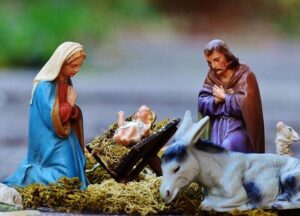Now that Thanksgiving leftovers occupy our refrigerators, our thoughts turn from orange and brown to red and green and from Plymouth Rock to Bethlehem. In just four short weeks, we will be celebrating the birth of the Messiah.
Christmas Day is the highlight of the year for many families, children, and retailers. We move toward this grand climax throughout the preceding twelve months anticipating the celebrations, the music, the gatherings, and the worship. It is understandably the premier holiday on the calendars of most Americans.
One of the most common Christmas decorations found in many homes, churches, and front yards is a Nativity Scene. These generally consist of a stable, some hay, various barnyard animals, Mary, Joseph, a couple shepherds, three wise men with their trusty camel steeds, and of course, the humble manger in the center holding a representation of the infant Son of God. These miniature dioramas help us to remember that first night in Judea over 2,000 years ago when God put on human flesh to live with us on earth. 
Many are surprised to learn that in spite of the most rustic stables we can muster, earliest tradition indicates that Jesus was born in a cave. The Bible doesn’t specify either the structure or the exact location of this holy birth, only that Mary laid the babe in a manger because there was no room for them in the inn.
Although a manger is an animal feeding trough associated with stables today, first century shepherds often used caves as shelters for their animals. It wasn’t uncommon for some homes to be built on or near such caves for this very purpose. It’s quite likely and even probable that Jesus was, in fact, born in a Bethlehem cavern doubling as a stable.
Luke is the historian that tells us of the inn and the shepherds and he, along with Matthew, also establish Bethlehem as the general birthplace in fulfillment of Micah’s prophecy some 700 years earlier. This favored town would soon pay the price for its privilege when Herod’s men arrived (a little late) to attempt to snuff out any newborn kings.
It’s no accident that Bethlehem was the birthplace, however. Not only did it fulfill prophecy, but its ancient name literally means House of Bread. The surrounding fields provided wheat for physical bread foreshadowing the Holy One born behind its inn who would be the true Bread from Heaven that would nourish all who would chose to partake of Him.
This small town was also the home of Naomi and eventually Ruth. Most of the book of Ruth revolves around the barley harvest in and around Bethlehem so it’s only appropriate that when her greatest grandchild, Jesus, was born 1300 years later, it would be here.
At the time of Jesus’ birth, Bethlehem was just a speck in the Middle Eastern hills. It didn’t even appear on many maps and certainly didn’t rival Rome, Athens, or Jerusalem in terms of size or popularity.
Today it is a bustling city of some 30,000 and The Church of the Nativity sits atop the traditional cave of Jesus’ birth. Although historians aren’t positive it’s the exact spot, local tradition establishing it as the site of the Incarnation date to within only 100 years of Jesus’ birth. It’s clearly possible this very cave under the church could be the precise location of His arrival!
One of the most remarkable aspects of Christianity is that its events took place within recorded history in specific locations. The entire Bible gives details regarding both times and places that have been and are being repeatedly verified by secular historians and archaeologists. Unlike pagan myths, Jesus wasn’t born in some fictional kingdom in a land before time. He wasn’t some shadowy figure glimpsed by only a privileged few on some mystical mountaintop. He became flesh and dwelt among us first in Bethlehem, later in Nazareth, Bethsaida, Capernaum, Samaria, Jerusalem, and a host of other precise locations that we can still visit today.
God came to be with us where we live and was physically present in our world. Next fall, Nancy and I will be leading a trip to Israel and visiting many of these very sites including His birthplace in Bethlehem. If anyone is interested in joining us, please contact me for details.
In the meantime, praise God for His physical visit to our time and place and begin anticipating the celebration of the greatest birth on earth!
In Jesus, George